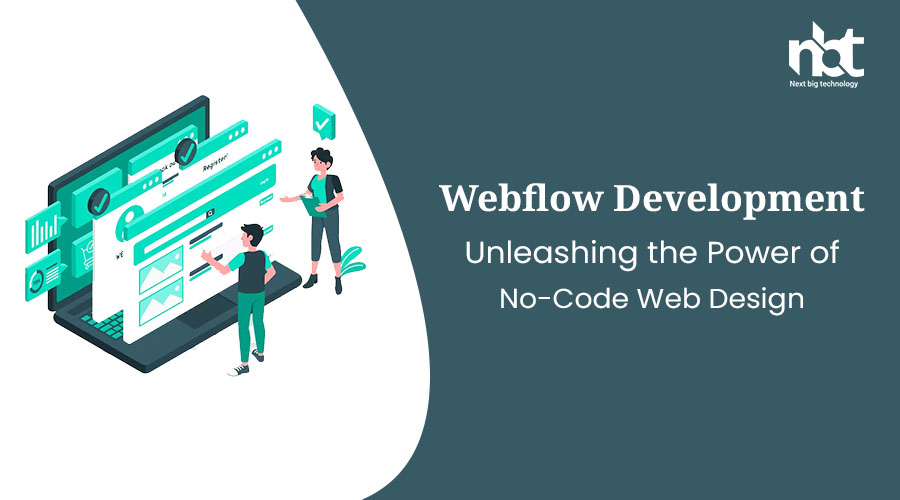Introduction:
In the world of web development, creating beautiful and functional websites has become easier with the emergence of no-code tools. Webflow, a leading no-code platform, has revolutionized the way websites are designed and developed. With its intuitive visual interface and powerful features, Webflow enables both designers and non-technical individuals to create stunning websites without writing a single line of code. If you’re interested in understanding the ins and outs of Webflow development and how it can empower you to build custom websites, this comprehensive guide is for you. Let’s dive in!
I. Understanding Webflow Development:
- No-Code Web Design:
- Webflow offers a no-code approach to web design and development, allowing users to visually create and customize websites using a drag-and-drop interface. The platform abstracts the coding complexities, making it accessible to individuals without coding expertise.
- Responsive Design:
- Webflow emphasizes responsive web design, ensuring that websites are optimized for different screen sizes and devices. Users can preview and customize the appearance of their websites for desktop, tablet, and mobile views.
- Design and Interaction Tools:
- Webflow provides a wide range of design and interaction tools, enabling users to create visually appealing websites with animations, transitions, and custom interactions. Users can bring their designs to life with ease.
- Content Management System (CMS):
- Webflow incorporates a built-in CMS that allows users to manage and organize website content effectively. Users can create dynamic pages, publish blog posts, and manage collections of content.
- Hosting and Publishing:
- Webflow offers hosting services, allowing users to publish their websites directly from the platform. The hosting infrastructure ensures fast and reliable website performance.
- E-Commerce Capabilities:
- Webflow includes e-commerce functionality, enabling users to build and manage online stores. Users can create product listings, set up payment gateways, and customize the shopping experience.
- SEO Optimization:
- Webflow provides tools and features to optimize websites for search engines. Users can customize meta tags, alt text for images, and define canonical URLs to improve search engine visibility.
- Integrations and Third-Party Services:
- Webflow integrates with various third-party services and tools, such as Google Analytics, Mailchimp, and Zapier. Users can extend the functionality of their websites and integrate with their preferred services.
II. Steps to Develop a Website with Webflow:
- Define Your Website’s Objectives:
- Determine the purpose of your website and identify your target audience. Clarify the key goals, functionalities, and design requirements that your website should fulfill.
- Familiarize Yourself with the Webflow Interface:
- Spend time exploring the Webflow interface and familiarize yourself with its features and tools. Understand the structure of the canvas, the panel layout, and the available options.
- Plan and Design Your Website:
- Create a wireframe or a visual design concept for your website. Consider the overall layout, typography, color scheme, and branding elements. Use Webflow’s design tools to bring your vision to life.
- Structure and Organize Your Website:
- Define the structure of your website by creating pages, setting up navigation menus, and establishing content hierarchies. Use Webflow’s visual canvas to create sections and arrange elements.
- Customize and Style Your Website:
- Use Webflow’s styling tools to customize the appearance of your website. Adjust typography, colors, spacing, and other design elements to create a cohesive and visually pleasing experience.
- Incorporate Interactions and Animations:
- Enhance user engagement by adding interactions and animations to your website. Use Webflow’s visual interface to define scroll effects, transitions, and other interactive elements.
- Set Up the CMS:
- If your website requires dynamic content, set up the CMS in Webflow. Define collections, create fields, and structure your content. Use the CMS to manage and publish blog posts, product listings, or other dynamic content.
- Optimize Your Website for SEO:
- Utilize Webflow’s SEO tools to optimize your website for search engines. Customize meta tags, add alt text to images, and optimize URL structures. Implement best practices to improve your website’s search engine visibility.
- Test and Preview:
- Use Webflow’s preview feature to test your website across different devices and screen sizes. Ensure that your website is responsive and functions properly.
- Publish and Launch:
- When you’re ready, publish your website using Webflow’s hosting services. Ensure that you have a custom domain or set up a subdomain to make your website accessible to visitors.
III. Conclusion:
Webflow has revolutionized web development by empowering individuals to create stunning and functional websites without coding. With its intuitive visual interface, powerful design tools, and comprehensive features, Webflow provides a no-code solution that bridges the gap between design and development. By following the steps outlined in this guide and leveraging the capabilities of Webflow, you can create custom websites that meet your objectives and captivate your target audience. Embrace the power of no-code web design with Webflow and unlock endless possibilities for your web development projects.










